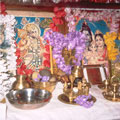|
|
 |
 |
| Rituals and Images in the Home |
|
|
The rhythms that shape daily life in the home are mirrored in home rituals (see Video clip 1: Home Puja). Many similarities exist between home-based rituals and those performed within a temple, though with great regional and personal variety. Deities are awakened early in the day and offered food and other gifts, and are then dressed and prepared for the coming day; the close of the day is accompanied by further worship. Not all Hindus give primacy to the human-made image in their worship, however. Other common forms of daily practice include the recitation of texts without reference to images and worship directed to the sun or river, which are considered natural images of the divine. Bathing in the Ganga (Ganges) or another sacred body of water, for example, is itself a form of worship (puja). In this case, the river is the Goddess herself, a natural image to be experienced, revered, and communed with through the ritual bath. Devotees will thus commonly be found bathing in the morning and evening, and praying before the bountiful waters of the river that brings life to the sprawling plains of north India (Figure 1).
In turn, daily rituals and worship shape everyday life, which is accented by special worship on festival days, during important life-cycle events, and as a part of the fulfillment of vows. Commonly observed life-cycle events include birth, high-caste initiation, marriage, and death. Vows are most often, but not exclusively, undertaken by women. A vow might consist of a promise to perform austerities of some kind in exchange for an articulated goal, or for the general well-being of the family. Such vows are an important way to rid the household of negative energy; those engaged in vows bring auspicious energy to the house, and through their austerities become worthy of reverence themselves. It is common, for example, for married women to fast on the holiday of Purnima, in the Hindu month of Jeth, in memory of Savatri, whose devotion to her husband saved him from death. When Savatri's husband fell sick, she fasted and undertook many vows, and when he died, she followed the God of death, Yama, as he took her husband away. Yama granted her a boon for her devotion, and she won back her husband. Women thus fast both in memory of Savatri's devotion and for the well-being and long lives of their husbands.
The form of worship in the home, as in the temple, often focuses on a central image, which can be permanent (Figures 2 and 3) and reside in the home shrine, or ephemeral -- created for a particular festival or cycle of worship. The sixteen core elements (upachara) known in temple worship are also utilized in home-based ritual. These sixteen upachara fall into four categories: (1) the deity is invoked in the image; (2) water is offered for washing; (3) the image is literally bathed, dressed, adorned, shown incense and a lamp (in a ritual known as arati), and offered food; and (4) the image is shown respect and bade farewell. Another common home-based ritual is the recitation of selections from sacred texts, or even of entire sacred texts. Often, a household will open its doors to friends and neighbors to partake in the meritorious act of public recitation, and in some cases those who attend participate in the reading, which can continue unbroken for days. While special shrines are often created for a particular celebration, sections of a house or portions of a wall may be permanently dedicated to making a place for the Gods within the home (Figures 4, 5, and 6).
Every person can worship her or his personal deity (ishtadevata) in the home, as well as in the temple. An individual family may also revere a clan or familial deity (kuladevata), who is associated with the family's ancestral place, just as an entire village may be devoted to a particular village deity (gramadevata), usually a Goddess and often associated with a natural feature of the village environment. Local and regional deities, in addition to the major deities of the Hindu pantheon, are revered in the home as well as in local community shrines.
In home ritual, the women of the family play a central role that maintains aspects of traditional gender distinctions, whereas formal ritual within most temples is dominated by men, often Brahmin priests. Home-based rituals are most often conducted by women for the sake of the safety and well-being of the household, and although it is in household worship that women come to play a prominent role, the entire process of worship owes much to the modes of behavior traditionally associated with women in the home. The idea of the deity as an honored guest, which is common to worship in both home and temple, is in some ways even more clearly articulated in the home setting: women are key to the welcoming and care of guests, and thus the behavior of the devotee in worship is in many ways analogous to the role a wife plays in the household.
In a fundamental way, worship also mirrors the relationship between husband and wife as it is traditionally conceived according to some conventional formulations, in which the wife is responsible for the care and honor of her husband. Worshipers relate to the deity as the wife does to the husband in this model, as an inferior who honors and provides nourishment and comfort within a loving relationship. Consumption of blessed food (prasad) at the end of worship in some ways demonstrates the hierarchical nature of this relationship and its atmosphere of intimacy and sharing, since often the wife consumes the remains of her husband's food when he has finished eating. Offerings to the Gods are frequently made as a preface to the consumption of the remainder of the food as the family meal, and in this way the offerings are fully integrated into the family's daily routine.
< previous next >
Top |
|
 |
 |
| Click for details |
 |
 |
 |
Fig. 1
|
 |
 |
 |
Fig. 2
|
 |
 |
 |
Fig. 3
|
 |
 |
 |
Fig. 4
|
 |
 |
 |
Fig. 5
|
 |
 |
 |
Fig. 6
|
 |
|
 |


